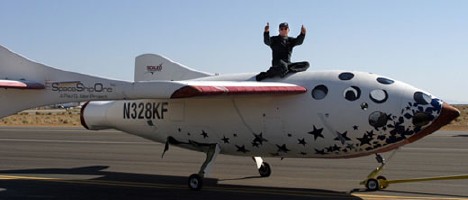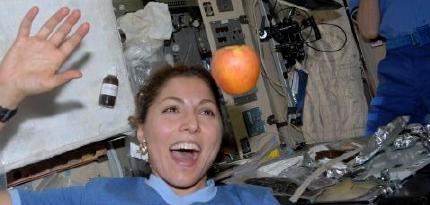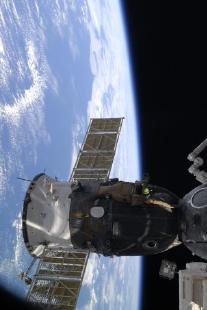TO COMMENT or Contact Me:
Use the e-mail address below.
 |
Nicholas Van Rijn Lives!
. . . so this is how Solar Spice and Liquor got started . . .
Posted March 31, 2006 by Mike
Via
Tokyo Times blog,
Mainichi reports on the
first commercially viable product from space:
Kochi counts down to launch of 'space sake'
KOCHI -- The world's first sake made from yeast that has traveled into space will be put on sale from April.
An association of sake breweries in Kochi Prefecture hit upon the idea of using space-traveled yeast in an attempt to invigorate the local sake industry.
Breweries put yeast produced in Kochi Prefecture aboard Russia's Soyuz rocket in the autumn last year. The yeast was then returned to them after the 10-day journey in space.
Using the space-traveled yeast, Kochi Prefecture breweries have produced 17 kinds of "space sake." (Mainichi)
Finally. Now can we get on with commercial space?
|
New! Improved! Space Engines!
NOT ten times as powerful, but still cool . . .
Posted January 21, 2006 by Mike
via
ALLAH, this interesting article on new ion engines being developed for space travel by the ESA caught my eye:
Super-powerful new ion engine revealed
Now, I don't know about you, but when I see the phrase "Super-Powerful", I think horsepower, or when talking space engines, THRUST, and lots of it.
Being a rocket-scientist type, this got my attention straight away. Zip, off to read the article, where the first line of the article dashed my hopes. I promptly scribbled out a comment on Allah's blog explaining some small points about ion engines.
It got long - too long just to be hidden away in Allah's comments section.
Sooooo, I've decided to post it here on my site also, with a few additions. Without further adoo, here it is:
The title of the article, "Super-powerful new ion engine revealed", is a little misleading. The first line of the article corrects the error by explaining that the new engine is ten times more efficient. For the non-rocket-scientist types out there, that's kinda like a new gasoline engine getting 10 times the milage, not ten times the horsepower.
The new engine is kinda cool as far as it goes, but they neglect to mention two little drawbacks of ion engines - electrical power requirements to perform the ionization, and the incredibly tiny thrust levels.
The kicker statement can be found in the second paragraph from the very end of the article, which manages to include both drawbacks in passing:
"Given sufficient electrical power, a cluster of DS4G engines could take a crew to Mars and back, says ESA."
First, the "Given sufficient electrical power" part. Back in the early 80's, a rather advanced ion engine required approximately 13,000 volts to operate. Working with a conservative value of 10 watts of power per square foot of solar array, you end up needing solar panels rivaling the size of the Mojave Desert to power the engine. OK, so that's a bit of an exaggeration, but they'd still be really, really big. And they'd only be useful close-in, like the afore-mentioned trip to Mars. Outward Bound, their efficiency would drop pretty rapidly as they moved away from the sun. You'd need to go nuclear in a big way to produce the necessary power over the required length of time (realistically, you'd want to do that for a Mars trip too, but nuclear powered spacecraft aren't exactly PC these days).
The second part, "...a cluster of DS4G engines..." is necessary due to the incredibly low thrust of ion engines.
Useful space engine thrust is not just about how fast you toss stuff off the back of the truck, but also about how much stuff you toss off. And ions, no matter how fast you toss 'em off, are really, really tiny, and only get tossed off one at a time. Therefore, the "cluster" of engines part.
Even with clustered engines though, the total thrust would be so low (less than one (1) pound of thrust), as to be useless for getting off the planet. When used in space however, they can accelerate a spacecraft continuously for months (or even years), allowing it to reach truly righteous velocities. Just so long as you remember to start decelerating it at the halfway point to it's destination, 'cause it will take it just as long to get slowed down as it did to get it up to speed in the first place. After all, zipping by your intended destination at a measurable (if small) percentage of the speed of light isn't really useful.
Still, 10 times the efficiency is pretty neat, even if it isn't ten times the thrust. Here's hoping they get it working in my lifetime.
Of course, nothing speeds development like a little competition, so how's about somebody offering a prize, ala the Ansari X-Prize, for the first spacecraft to make a round trip to Saturn and back within, oh, say, the next five to seven years. Winner will be the spacecraft with the lowest elapsed time for the trip.
And just to make it even more fun, there'd be an additional prize for the highest recorded speed when your spacecraft comes back by Earth. That's right - we wouldn't make you slow down to cross the finish line! Wouldn't it be just the coolest thing on Earth to hold the absolute SOLAR SYSTEM speed record?
. . . where's my calculator? I'm startin' now . . .
|
Mass Drivers
. . . with hostile intent . . .
Posted January 6, 2006 by Mike
Some time back, one of my brothers expressed a desire for a Mass Driver big enough to drop .. rocks .. on a certain foreign country (not Iraq) that was behaving . . . poorly. After some reflection, I came up with the following response.
Well...absolute size isn't a problem if the velocity is high enough (kinetic energy = 1/2mass x velocity2). And the right shape/material combination won't have a big problem with re-entry, even at orbital velocities.
The real problem is the energy source to power the critter. We'd probably need the Rolling Stones to help us out on that (reference to an old Heinlein SF story of the same name within which two young boys at one point get in trouble for setting up a nuclear reactor within city limits).
Or we could "borrow" Coulee for a bit.
Of course all this assumes we've come into a piece of property sufficiently large where we can build a turn-table big enough for the rail - I'm guestimating about 2 miles for the rail plus a minimum buffer zone of about 5 (500?) miles to minimize the ...umm....uhh....the umm.....environmental impact - yea; that's it - the environmental impact of throwing umm...."rocks"
ok, ok; - so they're spin-stabilized heavy-metal, aero-shaped, inert re-entry devices)
at obscene rates of speed
(think "The Mote in GOD's Eye" for a visual picture of one of these little toys leaving the rails' vicinity. For those of you who haven't read "Mote", think blindingly bright ionized hot plazma trail visible for light years).
And you'd need a bunch of spares (rails) - I think you can only use one of these things once - they tend to come apart due to the shock wave of the accelerating....rock.
Of course, all this presumes a patch of ground in eastern Washington, where there's air, and where we can personally drop the rocks into the launch chamber. Now if our little piece of real-estate were on the moon, or in orbit.....
Hey - we can dream, right? Any venture capitalists out there that like the idea of a "magnetic slingshot"? We could use it to shoot nuclear waste at the sun - no, really. We could. Honest, we could . . . and it would be fun !
Heh - somebody's gonna' end up hiring me out of pure self-defense !
|
Aerospace Employment Recovery?
I'll believe it when I see it . . .
Posted September 29, 2005 by Mike
Two years ago, the AIA released this press release:
Aerospace Employment Hits 50-Year Low
In the middle of the press release was this bit of info:
". . . Aerospace employment has dropped 106,000, or by 13 percent since September 11, 2001, and it has fallen by nearly half, or 642,000 since December 1989, a period that marks the end of the Cold War."
(emphasis mine)
A short time ago, NASA announced plans to return to the moon, and I commented that we'd have to learn how to do it all over again 'cause the people that had the relative experience were long-since gone.
Looking at the numbers above, it's much worse than that. Aerospace employment has dropped by nearly 50% since the end of the cold war. Cold War space program engineers were the most likely candidates to have had the necessary experience to help get to the moon. Unfortunately, many of them did not survive the 15-year-long reduction in aerospace employment. By the AIA's figures, the industry lost over 600,000 experienced employees. It could take decades to recover from that loss. After all, 'ya just don't train up experienced engineers overnight.
. . . what? . . . you think we're gonna get to the moon with engineers right out of school?
pffff
|
Moon or Bust (by 2018?!?)
. . . must not be real important . . .
Posted September 29, 2005 by Mike
October 4, 1957: The Russians launch Sputnik I into orbit, and the Space Race is on.
May 25, 1961: President Kennedy announces the goal of putting a man on the moon by the end of the decade.
July 20, 1969: Commander Neil Armstrong becomes the first man to walk on the moon, barely 9 years after starting the project.
October 4, 2004:
Burt Rutan's SpaceShipOne wins the X-Prize by putting private citizens into space twice with the same spacecraft within a two week period!
September 19, 2005: NASA
announces plans to return to the moon by 2018 (hat tip to Cold Fury). That's 13 years from now. It only took 9 years the first time, and we'd never done it before!
The concept uses mostly old technology, so it's not like we have to learn anything new.
. . . or do we?
Turns out, we don't have to learn anything new, per se. We do however have to re-learn a bunch of old stuff we knew a long time ago. It's new to us 'cause we haven't done it for 26 years. Learning it all over again will be just as painful the second time around, because while we may not make the same mistakes we made the first time, we'll probably make a whole new bunch this time. And all those guys that put men on the moon the first time 'round? They're almost all dead. And the ones that aren't dead are in their 80's, and even if they were willing, time and age do take their toll.
So we get to do it for the first time all over again. With the equivalent of 1/10 the budget, and not much support from the public or the critters back in Washington.
Come to think of it, we'll be lucky to get to the moon again by 2018. The only real question is whether or not a budding commercial space industry beats NASA to the punch.
Go Rutan! Go Rutan! Go Rutan! . . .
|
Take
THAT
NASA!
Scaled Composites Goes where NASA Wouldn't - Private Space!
Posted June 21, 2004 by Michael A. Morrow
Scaled Composites
has finally achieved what NASA refused to do for the last 21 years - put a private citizen in space. Three cheers to Mr. Rutan, and three jeers to NASA, who could have been selling rides on the shuttle for over 20 years.

Here's to many more!
|
Space
Take THAT NASA !
|




 Anousheh Ansari, the benefactor of the Ansari X-Prize won by Burt Rutan with his Spaceship One,
Anousheh Ansari, the benefactor of the Ansari X-Prize won by Burt Rutan with his Spaceship One,